
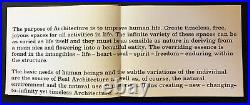
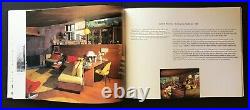
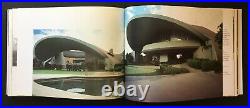


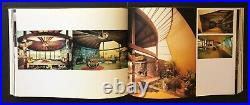
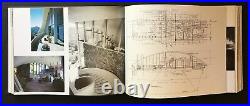
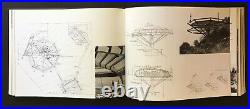
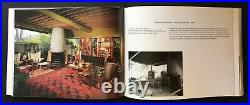

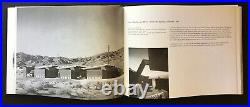
JOHN LAUTNER, ARCHITECT by Frank Escher. 1994 Artemis First Edition in Dust Jacket Designed by Lorraine Wild, ReVerb. 296 pages presenting nearly 50 realized buildings dating from 1940 to 1992. Frank Escher [Editor], Lorraine Wild, ReVerb [Designer]: JOHN LAUTNER, ARCHITECT. Embossed black cloth titled in white. Fully illustrated in color and black and white. Interior unmarked and very clean. Black cloth with a few random dust spots. Jacket flap offset marks to pastedowns. First two leaves lightly foxed. Monochromatic dust jacket sunned to edges, with faint shadow to front panel. A very good to nearly fine copy in a nearly fine dust jacket. 9.75 x 12.9375-inch hardcover book with 296 pages profusely illustrated with contemporary color photographs and vintage black and white images and plans of Lautner buildings, including The Chemosphere; the Arango Residence in Acapulco, Mexico; Desert Hot Springs Motel in Palm Springs; the Palm Springs Elrod Residence, and many others, all held together with Lorraine Wild’s sensitive typography and book design. This monograph is the most comprehensive presentation of John Lautner’s work ever published. Almost 50 realized buildings, dating from 1940 to 1992, are described and illustrated in detail. The book also includes a chronological list of work, a bibliography, an interview with Lautner in which he describes the most important influences on his work-among them his apprenticeship with Frank Lloyd Wright-and Lautner’s own highly individual views on architecture. John Lautner, FAIA (Michigan, 1911 – 1994) was one of the most important American architects of the twentieth century, and perhaps one of the most misunderstood. His career spanned fifty-five years and left an indelible mark on the built environment of Southern California. Lautner was born in 1911 and raised in Marquette, Michigan. His remarkable natural surroundings made a deep and lifelong impression. He had his first building experience at the age of twelve, when he helped his father construct a chalet designed by his mother. He earned a degree in English from what is now Northern Michigan University, whose only architecture class at the time was a history survey. After reading Frank Lloyd Wright’s autobiography, Lautner applied to Wright’s Taliesin Fellowship in Spring Green, Wisconsin. He served from 1933 to 1939 as one of Wright’s original Taliesin Fellows. Lautner adopted Wright’s philosophy of “organic architecture, ” which promotes harmony between man and nature by exploring the interplay of people, spaces, and the natural and built environments. He began practicing in Los Angeles in the late 1930s. Lautner designed over fifty significant structures in Southern California alone, each a unique expression of his constant exploration of new ideas and materials. Unlike Michigan, the Southern California climate and light allowed Lautner to use large planes of glass, exposed wood, and other elements that brought nature into his designs. He was an engineering genius, able to juxtapose different angles and shapes to create forms that were at once organic and futuristic. He pioneered the use of concrete as both a sculptural and architectural element. He was instrumental in creating the California coffee shop, designing both Googie’s and Tiny Naylor’s (both demolished). Yet most of his best-known works are residential, with iconic designs including the 1960 Malin residence (Chemosphere) in the Hollywood Hills and the 1963 Reiner residence (Silvertop) in Silver Lake. In 1970, Lautner became a Fellow of the American Institute of Architects. He received the Gold Medal from the Los Angeles AIA chapter in 1993. Lautner was active in a number of projects when he died in 1994 at the age of 83. Despite its great significance, Lautner’s work was largely overlooked in his lifetime. It has gained increasing recognition in the years since, with exhibitions, publications, a documentary, and appearances in numerous films, commercials, and other media. Yet his legacy remains vulnerable. His 1951 Shusett House in Beverly Hills was demolished in 2010, and AbilityFirst’s Paul Weston Work Center (1979) in Woodland Hills was proposed for demolition in 2014. The Los Angeles Conservancy. For an excellent and ever-changing selection of rare and out-of-print design books and periodicals covering all aspects of 20th-century visual culture. Please contact me for details.